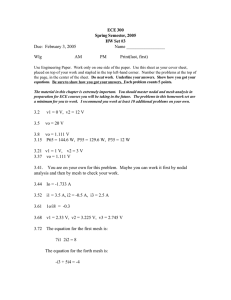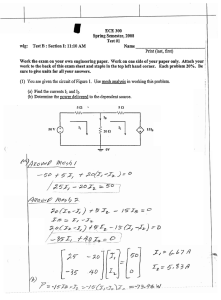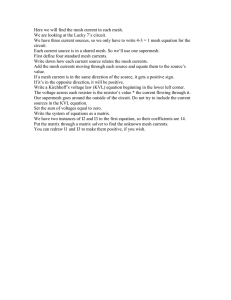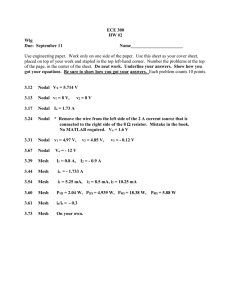Nodal & Mesh Analysis: Circuit Analysis Techniques
advertisement
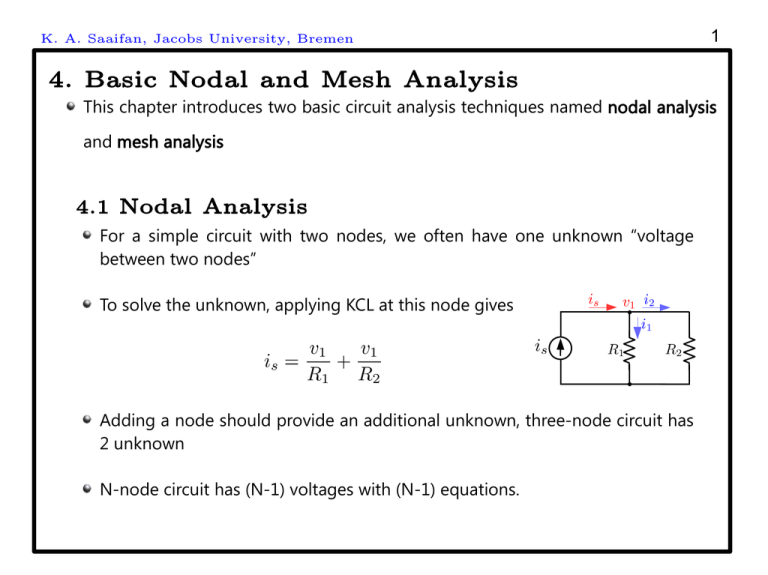
K. A. Saaifan, Jacobs University, Bremen 1 4. Basic Nodal and Mesh Analysis This chapter introduces two basic circuit analysis techniques named nodal analysis and mesh analysis 4.1 Nodal Analysis For a simple circuit with two nodes, we often have one unknown “voltage between two nodes” To solve the unknown, applying KCL at this node gives Adding a node should provide an additional unknown, three-node circuit has 2 unknown N-node circuit has (N-1) voltages with (N-1) equations. K. A. Saaifan, Jacobs University, Bremen Nodal technique applies the following step 1- Count the number of nodes (N) 2- Designate a reference node 3- Label the nodal voltages (we have N-1 voltages) 2 3 K. A. Saaifan, Jacobs University, Bremen 4- Write KCL equations for the non-reference nodes (currents in = currents out) 5- Organize the equations (1) (2) 6- Solve the system of equations for the nodal voltages K. A. Saaifan, Jacobs University, Bremen Using a Cramer's rule and determinants, we have 4 5 K. A. Saaifan, Jacobs University, Bremen Compute the voltages at each node Ans: Write KCL equations for the three nodes Organize the equations (1) (2) (3) 6 K. A. Saaifan, Jacobs University, Bremen Compute the voltage at each node Ans: Solve the system of equations for the nodal voltages Use a Cramer's rule and determinants to solve the system 7 K. A. Saaifan, Jacobs University, Bremen 4.2 Nodal Analysis with Supernode A supernode is formed when a voltage source is the only element connected between two essential nodes 1- Define a current through the source and write KCL equations for the two nodes 2- We note that there is no need to determine ivs to solve the circuit (1) 3- Apply KVL between the two nodes (2) Thus, the KCL at the supernode is directly given by 8 K. A. Saaifan, Jacobs University, Bremen Determines the node-to reference voltages . Node 1 to reference is supernode Node 2 Node 3 & node 4 Express vx=v2-v1 and vy=v4-v1 in terms of nodal voltages and organize the equations (1) (2) (3) Solve to get 9 K. A. Saaifan, Jacobs University, Bremen 4.3 Mesh Analysis In nodal analysis, circuit variables are node voltages Nodal analysis applies KCL to find unknown voltages In mesh analysis, circuit variables are mesh currents Mesh analysis applies KVL to find unknown currents Both methods result in a system of linear equations Mesh analysis is only applicable to a circuit that is planar Planar vs. Non-planar Circuits Planar circuit: it can be drawn on a plane surface where no branch cross any other branch (element) Non-planar circuit there is no way to redraw it and avoid the branches crossing Planar circuit Non planar circuit 10 K. A. Saaifan, Jacobs University, Bremen Mesh & mesh current A mesh is a property of a planar circuit and it is defined a loop that does not contain any other loops within it The current through a mesh is known as a mesh current mesh mesh K. A. Saaifan, Jacobs University, Bremen 11 4.3 Mesh Analysis 1. Determine if the circuit is a planar circuit. If not, perform nodal analysis instead. 2. Count the number of meshes (M) 3. Label each of the M mesh currents (defining all mesh currents to flow clockwise results in a simpler analysis) 4. Write a KVL equation around each mesh For mesh 1, we have or (1) For mesh 2, we have or The solution is easily obtained (2) 12 K. A. Saaifan, Jacobs University, Bremen Determine the power supplied by the 2 V source . i1 We first define two clockwise mesh currents For mesh 1, we write the following KVL equation The same for mesh 2, we write i2 K. A. Saaifan, Jacobs University, Bremen Rearranging and grouping terms, we have and Solve the both equation yields i1=1.132 A and i2=-0.1053 A The 2 V source supplies (2)(i1-i2)=2.4 W 13 K. A. Saaifan, Jacobs University, Bremen 14 4.4 The Supermesh Similar to the supernode in a node voltage analysis A supermesh is formed when a current source is the only element connected between two meshes 1- Define a voltage across the source and write KVL equations for the two meshes and 2- We do not need to evaluate vcs to solve the circuit 3- This leads us to create a supermesh whose interior is that of mesh 1 and mesh 2 4- Finally, the source current is related to the mesh currents, 15 K. A. Saaifan, Jacobs University, Bremen Determine the three mesh currents . i1 i2 i1 i2 i1-i2 i1-i2 i3-i2 i3 i3-i2 i3 i1-i3 The 7 A independent current source forms a supermesh between mesh 1 and mesh 3 Applying KVL over the supermesh gives or KVL for mesh 2 or K. A. Saaifan, Jacobs University, Bremen Homework Assignment 3 P4.8, P4.10, P4.14, P4.22, P4.26, P4.31, P4.36, P4.44 16
